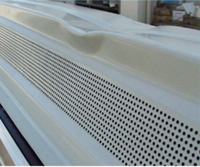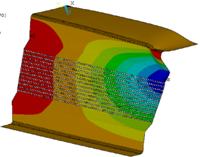|
Based on theoretical considerations of carrying- and distortion behaviour, the influence of the perforation to flexural- and axial rigidity on reduced rigidities was captured. By reference to the rigidity of the unperforated profile the resulting factors dij(axial rigidity) and kij (flexural rigidity) allow to extend the existing calculation methods for thin-walled building parts to fully perforated parts in a comparative simple way. This was demonstrated using the example of the calculation of the carrying capacity for fully perforated surfaces stressed by compression and shear.
For partially perforated surfaces, stressed by uniaxial compression, a simple arithmetical method for the calculation of the necessary buckling factors of bearing capacity of thin-walled building parts was derived based on field transfer matrices. For the subsequent calculation of cross section carrying capacity of partially perforated surfaces, a simple method was deduced, too.
Further analyses cover the shear force carrying capacity of perforated building parts. The existing calculation methods for the proof against web crippling were extended with the help from theoretical considerations and reduced rigidities for the use of fully perforated webs. Based on comprehensive numeric analyses, a secure and cost-effective calculation method could also be developed for partially perforated webs.
back |

 |



